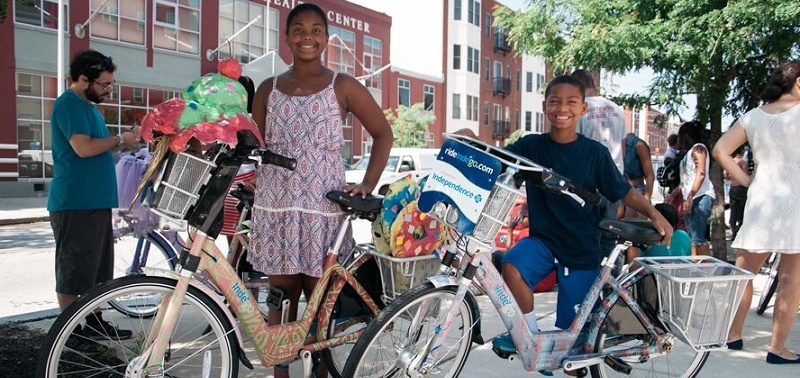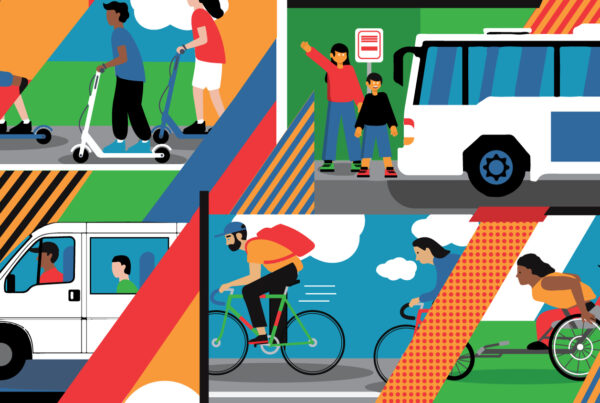Recently, the Better Bike Share Partnership concluded a call for proposals for its second round of Challenge Grants to help increase bikeshare use in underserved communities across the U.S. Its first round helped support several important efforts, from launching a bilingual bikeshare outreach campaign in Austin to expanding the reach of Boston Medical Center’s “Prescribe-a-Bike” program.
While great progress has been made on the equity front – and there is no doubt that bikesharing has great potential to increase transportation choice, improve health and boost public perception of biking – the general consensus remains that more must be done to reach and engage diverse communities.
The issue of bikeshare equity came up in several panels throughout the three-day Move Together conference, which was conducted by the Shared-Use Mobility Center (SUMC) in partnership with the North American Bikeshare Association (NABSA). Drawing on insights shared by government, nonprofit and private sector experts across several sessions, here are five ways that a city can build a more equitable bikesharing system:
1. Grow the biking culture. During Monday’s lunch plenary Reshaping the Model: Shared Mobility for All, Slow Roll Chicago President and Co-Founder Oboi Reed discussed his group’s efforts to get people on bikes – a key factor that is often overlooked in attempts to expand bike equity. After all, a city could have the world’s most affordable, station-rich bikesharing system, but if people are hesitant to ride, it’s all for naught. To get people excited about biking, Slow Roll holds regular neighborhood rides and works to create an interesting, social experience that inspires people to participate. The organization also partners with community groups to provide loaner bikes and conducts outreach on behalf Divvy for Everyone, a program designed to increase access and ridership for Chicago’s Divvy bikeshare system among low-income residents.
“We don’t believe in a ‘build it and they will come’ strategy,” said Oboi in an interview with SUMC earlier this year. “You have to connect with people in an emotional way and make them feel safe. Part of that is making biking a culturally relevant experience.”
2. Prioritize grassroots outreach. During Tuesday’s session on New Strategies for Expanding Options, Indego bikeshare Community Relations Manager Kiera Smalls talked about ways to use grassroots marketing to engage residents and attract riders from a diverse range of communities. For instance, this summer Indego partnered with Philadelphia elementary school students to design art for display on its bikeshare bikes. Indego then used the art to create special wraps for 10 bikes and encouraged residents to Tweet and Instagram photos of the bikes throughout the city using the hashtag #ridingmurals for a chance to win prizes. The campaign created a great deal of buzz and, importantly, the Indego team kept the conversation going after the six-week promotion ended.
Smalls also discussed the important role that events can play in reaching community members. Her team has a regular presence at neighborhood events throughout Philadelphia and uses discounts, giveaways, and on-site membership registration to encourage attendees to become Indego members. Thanks in part to Smalls’ efforts, Indego today has 7,000 memberships, nearly 300,000 completed trips and more than 7,000 social media fans.
“Meeting people where they are, either online or at events, is the new way of marketing,” Smalls said. “Indego’s success would not be possible without prioritizing grassroots outreach.”
3. Focus on building strong relationships. For Katie Monroe, Bike Share Outreach Manager for the Bicycle Coalition of Greater Philadelphia, effective outreach begins and ends with relationships.
“There are no shortcuts in relationship building, either at the policy level or the citizen level,” she said during her presentation during Monday’s equity plenary at Move Together. Monroe pointed to the Coalition’s ambassador program – which uses community leaders to help increase awareness for bikeshare in underserved neighborhoods – as a best practice for building connections with residents.
“The largest overall challenge is that people don’t necessarily trust these bikes coming into their neighborhood,” she said. “They are seen as symbols of gentrification.” Relationship-building initiatives like the ambassador program can help overcome suspicion and get people excited about bikeshare.
Building relationships with the right community-based organizations can also help systems amplify their efforts to reach new residents. For instance, in Chicago applicants can sign up for a Divvy for Everyone discounted bikesharing membership at any of five financial opportunity centers run by the Local Initiatives Support Corporation (LISC), a nonprofit with deep roots in the city whose programs reached more than 40,000 residents in 2014.
4. Make the right policy decisions up front. According to Monroe, it’s also important for cities to make the right policy decisions at the outset that dictate key bikeshare system details such as payment options and station location. In Philadelphia, equity was a focus from the Indego system’s early planning stages. As a result, one third of its stations are located in low-income neighborhoods and its payment system is explicitly designed to accommodate users who don’t own credit cards.
According to City of Philadelphia Bicycle Programs Manager Aaron Ritz, who also spoke at Tuesday’s session, mobility operators need to start by figuring out what solutions will work best for the people they are trying to serve. After all, before you can change bikeshare, you need to know who uses it and how they use it. “Listen first, adjust your ideas, then spread the word,” said Ritz.
5. Anticipate and address barriers to payment.
Unlike many other bikesharing systems, Indego does not offer a lump-sum annual membership rate. According to Ritz, people in low-income neighborhoods were receptive to Indego’s $15 monthly membership, but balked when that amount was translated to $180 per year.
Some of that may be a matter of messaging, but studies also suggest that low and moderate-income residents are more likely to buy monthly transit passes than riders in higher income brackets due to cash flow concerns and the desire for greater flexibility.
A working paper on equity released by the National Association of City Transportation Officials (NACTO) earlier this year found that low-income people similarly benefit from installment or monthly payment options for bikesharing. While the total cost of an annual bikeshare membership may not be entirely out of reach for these residents, many prefer not being locked into a year-long commitment.
As those familiar with the industry know, the method of payment a bikesharing system uses can also present challenges for low and moderate-income riders, many of whom do not have access to credit cards or bank accounts. However, progress is being made on this front as well. Chicago and Arlington County, Virginia are addressing this issue by allowing participants to pay for memberships using cash. In Philadelphia, Indego partnered with PayNearMe, an electronic transaction network that enables consumers to make online purchases using cash at retail chains such as 7-Eleven and Family Dollar.
The challenge now is for cities and systems to build on this momentum and work to ensure that the benefits of bikesharing extend to all residents regardless of race, age or income. The Shared-Use Mobility Center plans to continue documenting relevant advancements in the coming months and will release a whitepaper on equity best practices for mobility operators in early 2016.
Image credit: Darren Burton



